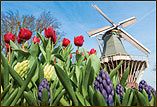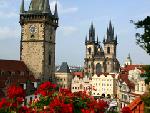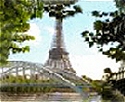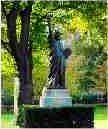|
Gustave Eiffel was born in Dijon on December 15, 1832.
His father was an emigrant from the Rhineland who's parents had
established themselves in Paris at the beginning of the 18th century.
His grandfather's name was originally Boenickhausen, which he changed to
Eiffel in memory of the Eifel plateau near Cologne. His father,
Alexandre Eiffel, at the age of 16, served in Napoleon's army in 1811.
In 1824, his father married Catherine Moineuse.
High School and College
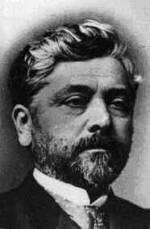 |
After graduating from high school in Dijon in 1850, Gustave went to the
Ecole Centrale des Arts et Manufactures, graduating in 1855. During that
same year, Paris hosted the first world's Fair. He joined a
Belgian firm which specialized in railway equipment. He spent
several years in the South West of France, where, when he was 26
years of age, supervised work on the great railway |
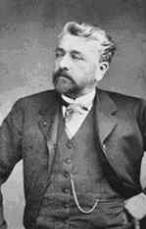 |
| Gustave
Eiffel |
bridge in Bordeaux.
|
Gustave Eiffel |
Marriage
In 1862 he married Marie Gaudelet. The Eiffels had three daughters:
Claire, Laure and Valentine and two boys: Edouard and Albert.
Engineer-Constructor
He set up his own business, in 1864, as an "engineer-constructor"; that
is, as a business specializing in metal structural work. He went on to
build hundreds of metal structures of all kinds, all around the world.
Bridges, and in particular railway bridges, were his favorite field of
work, but he also won renown for his metal structural work and
industrial installations.
Viaducts and Statue of
Liberty
His career was marked by a large number of fine structures. This
included four viaducts of trussed-girder design between 1867 and 1869.
The one at Rouzat, west of Vichy France, featured wrought-iron towers
that visibly reflected the need for lateral stiffness to counter the
influence of horizontal wind loads.
His outstanding career as an engineer-constructor was marked by work on
the Porto viaduct over the river Douro [1876], the Garabit viaduct
[1884], Pest railway station in Hungary [1881-82], the rotating dome of
the Nice observatory [1886], and the ingenious structure of the Statue
of Liberty [1881-82]. viaduct over the river Douro [1876], the Garabit viaduct
[1884], Pest railway station in Hungary [1881-82], the rotating dome of
the Nice observatory [1886], and the ingenious structure of the Statue
of Liberty [1881-82].
Portable Bridge Kit
During this creative period of 1881-82, he also invented a revolutionary
portable bridge kit that could be assembled
| by 12 men in just a few days. |
|
Nice Observatory |
He furnished bridge kits, consisting of some 4000 meters of
bridging, to railroads, armies and third world countries. His design was
the basis for the Bailey Bridges that were used so successfully, for
river crossing, by the Allies during WWII. His career culminated in 1889
with his crowning achievement, the Eiffel Tower.
Eiffel Tower
Eiffel was a master of elegantly constructed wrought-iron lattices,
which formed the basis of his bridge construction and led to his project
for the Eiffel Tower. He was mainly recognized as an engineer and bridge
builder.
Pictures of Maria Pia Bridge & Gatabit Viaduct [see Statue of Liberty]
Railroad and Highway
Bridges.
Eiffel was responsible for the construction of a wide number of large
structures all over the world. He built some of the world's most
important 19th century railway bridges as well as a large number of
highway bridges. Other structures, in which the pure inventiveness of
Eiffel's company was allowed free rein, are extraordinary. These include
his "portable" bridges, which were sold around the world in "kits", the
ingenious structure of the Statue of Liberty in New York and, of course,
the Eiffel Tower itself.
Panama Canal
In 1887 Eiffel agreed to build the locks of the Panama Canal, an immense
undertaking badly managed by Ferdinand De Lesseps. This undertaking
ended in the biggest financial scandal of the century.
The Panama Canal venture, which began in 1881, was the biggest contract
in his entire business career, and also the one with the greatest risk.
Given the risk he faced, he was granted major financial advantages and
solid guarantees, which allowed him to collect his profit as soon as the
work was begun.
Despite the care which Eiffel took in managing the project, the
liquidation of the canal construction company, Compagnie du Canal, on
February 4 1889, led to his own indictment for fraud alongside De
Lesseps and his son. Even though nothing could really be blamed on him
personally, he was sentenced to two years in prison and a fine of 2000
francs,. With his honor and dignity severely compromised, he withdrew
from business. The ruling was later annulled, in 1893, by the highest
French appeals court, the Cour de Cassation. The court cleared Eiffel of
all wrongdoing. The ruling liberated him from all obligations concerning
the accusations. This put an end to any further court action against
him.
Scientific Experimentation
After the end of his imminently successful career in business, which was
only marred by the debacle of the Panama Canal venture with Ferdinand de
Lessups, Eiffel began an active life of scientific experimental research
in the fields of meteorology, radiotelegraphy and aerodynamics
experimenting to prove the usefulness of his tower.
He had begun to develop a passionate interest in that which, at the turn
of the century, was considered avant-garde science: meteorology,
radiotelegraphy and aerodynamics. He devoted the final thirty years of
his life to a fruitful career as a scientist.
|





 viaduct over the river Douro [1876], the Garabit viaduct
[1884], Pest railway station in Hungary [1881-82], the rotating dome of
the Nice observatory [1886], and the ingenious structure of the Statue
of Liberty [1881-82].
viaduct over the river Douro [1876], the Garabit viaduct
[1884], Pest railway station in Hungary [1881-82], the rotating dome of
the Nice observatory [1886], and the ingenious structure of the Statue
of Liberty [1881-82]. 